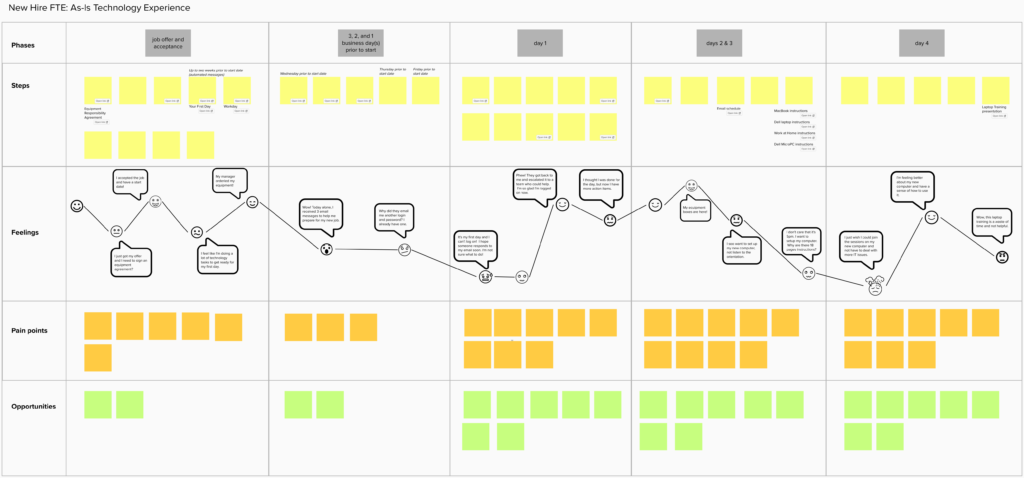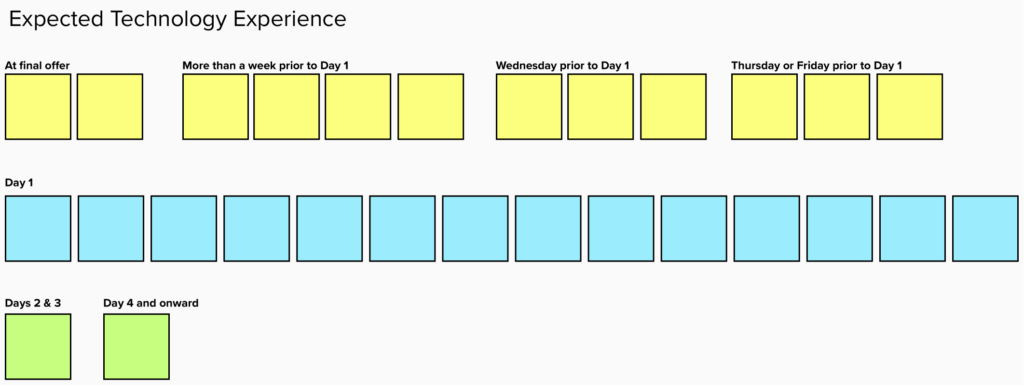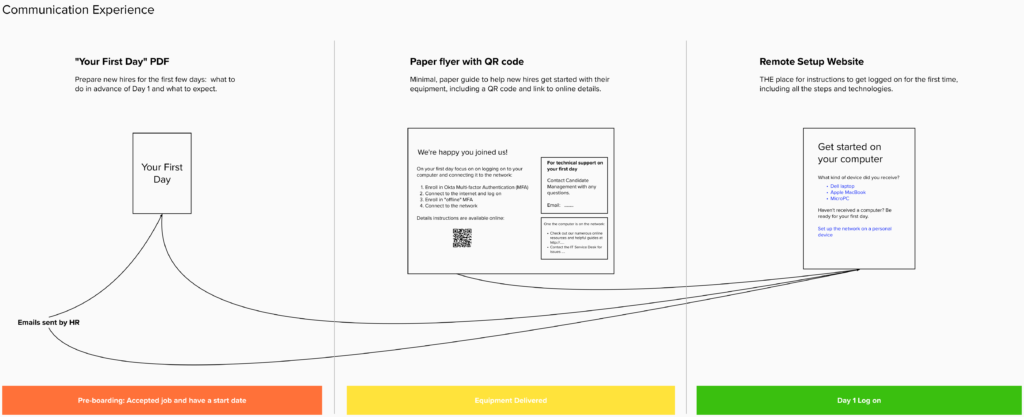Project description
In this project, a large insurance company was interested in improving their new employee onboarding. With the COVID pandemic, they had switched to a completely remote format and recognized that it was an experience wrought with technical difficulties. All new hires were using a virtual machine for the first few days until their company-provided computer was shipped to them.
My work was to champion the new hire, IT onboarding experience. I improved the equipment delivery and initial technology set up experience, as well as all of the communications sent to new hires and hiring managers.
Initial research
To start the project, I completed an internal, research project to understand the current experience and the stakeholders involved. Talking with the stakeholders, I learned about their roles, concerns, and pain points with the current processes. The IT delivery team members, for instance, described not having an accurate shipping addresses and incurring large costs by sending equipment to the wrong location.
Beyond the internal concerns, I also looked at the current, end-to-end experience. I reviewed the existing survey data and interviewed recently hired employees to create an as-is journey map. The journey map told the story of a new hire’s onboarding adventure, including points of excitement, frustration, and confusion. It included links to the artifacts I collected in the interviews.

Design approach
Analyzing the current experience, the journey map identified numerous pain points and opportunities. Reviewing this with the Product Management team, we collaboratively identified 5 impactful features to provide in the initial MVP:
- Ship equipment to an accurate address
- have it arrive before Day 1
- Ensure log on and network access on Day 1
- Simplify paper instructions
- focus on first-time log on steps
- ensure accurate information
- use an online format with videos and text
- Coordinate communications shared with new hire
- align messaging and reduce number of emails sent
- use a single point of contact for technical support
- Share equipment tracking information with new hires
- encourage them to be available to receive equipment boxes
I created a diagram to illustrate the experience of the planned MVP.

I was an advocate for the new hire in each of the MVP features, but most of my work was to directly lead three of the features: simplify paper instructions (#3), coordinate communications (#4), and share tracking information (#5).
Design: Simplify paper instructions
I identified the lengthy and out of date printed instructions in my initial research. To begin the design work, I reviewed four sets of existing, printed instructions in detail and collaborated with the Technical Writer to simplify and reduce them as much as possible. We also met with numerous technical teams to ensure the accuracy of the instructions before publishing them on an external facing website.
I designed the information architecture of the website and tailored it to the different types of employees and equipment solutions provided. The site provides both text and video. It uses a mobile-first, accessible design that has been usability tested. Working with an engineer, we published two versions of the site due to a shift in log on approaches mid-project. Here is the site map I created to outline the pages for the two approaches.

I realized the cumbersomeness of the existing log on approach early in the project. Working with the Information Security team, we identified a way for new hires to log on without taking action before day 1.
Design: Improve communications
Looking at the end-to-end experience, I recognized that 3 different groups shared technology instructions with the new hires in an uncoordinated way during their first week. Human Resources, Information Security, and IT Equipment all had different information to communicate. My work aligned these and ensured a consistent messaging.
The website replaced not just the paper instructions, but the dated, technical instructions sent by HR and the emails sent on the first day by Information Security. Collaborating and coordinating with these teams, the new website provides a single source of information.
I designed a single-page handout with a QR code to include with the equipment box. I also created a diagram to show how the multiple communications would connect for a seamless experience.

Experience-Based Roadmap
Prior to my joining in the project, an Experienced-Based Roadmap was created across the Human Resources and IT partners to improve the new hire onboarding experience in general. The roadmap documented a series of iterative releases and assumed that all new hires would attend onboard remotely.
The business has since changed direction and is planning to bring all new hires onsite for orientation. I have updated the roadmap to reflect this shift and analyzed the project’s current state. I conducted interviews with recent new hires, reviewed the survey results, and consulted the metrics about equipment delivery. Some experience goals have been completed, others are making great progress, others still need work, and some have not yet been started.
After reviewing the current state with the Product Managers, I organized a collaborative workshop to identify a new iteration. Our next iteration will provide an improved, incremental end-to-end experience. New full-time employees need to be prepared to start work using the organization’s collaborative tools. This is a natural next step after ensuring everyone has IT equipment and usable log on instructions.
In another future iteration, I also plan to improve the hiring manager experience so they are better prepared to help their new hire.

Impact
Here is a summary of my impact
| Prior to my involvement | My success stories |
| All new hires used a virtual machine, struggling to install, configure, and use it on their personal computer or tablet | None of the new hires are using a virtual machine |
| All new hires received their computer on their fourth day of employment | Laptop are provided to new hires on or before their first day. All other new hires receive their desktop on the first day of their computer training. |
| Many new hires lacked access on Day 1 and could not log on to the corporate network | All new hires have corporate network access on Day 1 |
| All new hires were sent 18 pages or more of outdated, computer set up instructions | New hires with shipped equipment receive an accurate, one page handout |
| Computers were shipped to incorrect addresses | New hires verify their shipping address as part of a standard Human Resource process |
| New hires missed the equipment delivery, leading to unattended equipment or additional effort to acquire equipment | New hires receive tracking information for their equipment |
Wrap-up
This project started with a simple interest in getting remote new hires their equipment sooner. Looking at the end-to-end experience, I realized there was more ways I could improve new hire’s journey. Sharing ~18 pages of printed instructions to set up a new computer was not helpful. I created a better experience with a simplified, mobile-friendly website.
As the project continues, I look forward to making additional improvements. The scope of the initial MVP release was significant, but there is more to IT onboarding than just delivering a computer and providing initial log on instructions. I am excited to define the next release, including acceptance criteria and metrics to track success.